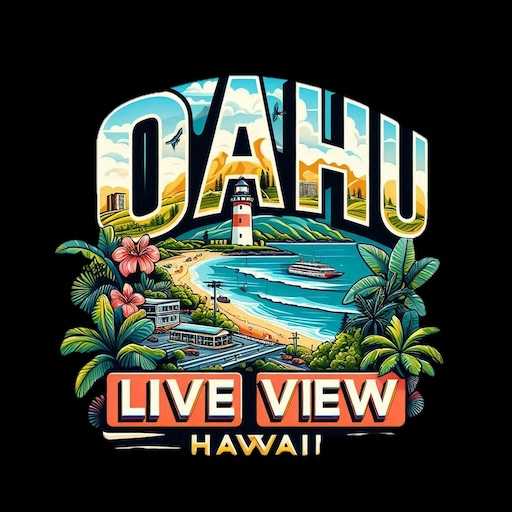Kaneohe Bay, Oahu Webcams
Kaneohe Bay FAA Webcam
Kāne‘ohe Bay: A Window into Oahu’s Natural and Cultural Heritage
Kaneohe Bay, Oahu Webcams. Nestled on the windward coast of Oahu, Kāne‘ohe Bay is one of Hawaii’s most picturesque and historically significant marine environments. Its calm, turquoise waters are home to vibrant coral reefs, unique marine life, and numerous islands, while its shores have witnessed centuries of cultural and historical events. From ancient Hawaiian traditions to pivotal moments in military history, Kāne‘ohe Bay offers a rich tapestry of stories.
The Name and Ancient Hawaiian History
The name Kāne‘ohe translates to “Bamboo Man” in Hawaiian, originating from a local legend involving a man who was said to be cruel to his wife. She compared his personality to the sharp edge of cut bamboo, and the name stuck. Beyond the legend, Kāne‘ohe Bay was a vital resource for ancient Hawaiians, who thrived in its fertile lands and bountiful waters.
Hawaiians built numerous fishponds, or loko i‘a, around the bay, showcasing their sophisticated aquaculture techniques. These fishponds, some of which are still visible today, were designed to trap fish at high tide, providing a sustainable food source for the community. The bay also played a central role in Hawaiian spiritual practices, with sacred sites and heiau(temples) dotting the surrounding landscape.
One of the notable features of Kāne‘ohe Bay is Mokoli‘i, also known as Chinaman’s Hat, a small islet just offshore. Mokoli‘i is steeped in Hawaiian mythology, believed to be a piece of the tail of a lizard-like creature, or mo‘o, that was defeated by the goddess Hi‘iaka.
Western Contact and Sugar Plantation Era
The arrival of Western explorers in the late 18th century marked a period of significant change for Kāne‘ohe Bay and its surrounding communities. In 1778, Captain James Cook’s arrival in the Hawaiian Islands heralded the onset of Western influence. By the 19th century, the traditional Hawaiian way of life around Kāne‘ohe began to shift due to the introduction of Christianity, Western technology, and diseases that decimated the native population.
In the mid-19th century, Kāne‘ohe and the windward coast became sites for sugarcane and pineapple plantations. The fertile lands and abundant rainfall made the region ideal for agriculture. Immigrant laborers from China, Japan, Portugal, and the Philippines were brought to work on the plantations, forever altering the demographic and cultural makeup of the area.
While agriculture thrived for a time, the plantations began to decline in the early 20th century due to competition and changing economic conditions. The lands surrounding Kāne‘ohe Bay transitioned to other uses, including military installations.
The Military Era: From World War II to the Present
Kāne‘ohe Bay played a strategic role during World War II. The Kāne‘ohe Naval Air Station, now known as Marine Corps Base Hawaii (MCBH), was established on Mokapu Peninsula, the prominent landform that juts into the bay. The air station became an essential base for seaplane operations, connecting Hawaii to other Pacific outposts.
On December 7, 1941, just minutes before the attack on Pearl Harbor, Japanese forces launched an assault on Kāne‘ohe Naval Air Station. The attack inflicted significant damage on U.S. aircraft and marked the beginning of Hawaii’s involvement in World War II. Several buildings and hangars from that era still stand today and are listed on the National Register of Historic Places as part of the Pearl Harbor National Historic Landmark.
After the war, the air station evolved into Marine Corps Base Hawaii, serving as a critical training and operations hub for the U.S. military in the Pacific. While much of the bay remains accessible for recreational and cultural activities, the presence of the military base underscores its continued importance in national defense.
Natural Beauty and Ecological Significance
Kāne‘ohe Bay is the largest sheltered body of water in the Hawaiian Islands and is renowned for its unique ecological features. The bay is home to the only true barrier reef in Hawaii, stretching nearly 5 miles. Its shallow waters host an incredible diversity of marine life, including corals, fish, and green sea turtles (honu).
The bay also contains several small islands and sandbars, the most famous being Ahu o Laka, commonly referred to as the “sandbar.” This spot is a popular destination for locals and visitors, offering a surreal experience of standing on a patch of sand surrounded by miles of water.
In recent decades, efforts have been made to protect and restore Kāne‘ohe Bay’s delicate ecosystem. Pollution, overfishing, and invasive species have posed challenges, but conservation initiatives led by local organizations and researchers aim to preserve the bay’s natural beauty for future generations.
Kāne‘ohe Bay Today: A Blend of Heritage and Recreation
Today, Kāne‘ohe Bay remains a cherished site for both residents and visitors. Its calm waters are perfect for kayaking, paddleboarding, and snorkeling, while its vibrant coral reefs provide opportunities for underwater exploration. The bay also continues to be a source of cultural inspiration, hosting events and ceremonies that celebrate Hawaiian traditions.
For many, Kāne‘ohe Bay represents the convergence of natural splendor, cultural heritage, and historical significance. It is a place where the echoes of Hawaii’s past resonate alongside the rhythm of modern life. Whether seen from the lush ridges of the Ko‘olau Mountains or experienced up close on the water, Kāne‘ohe Bay stands as a testament to the enduring beauty and resilience of Oahu.
For more information, visit the official Oahu website.
